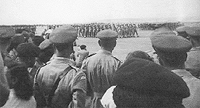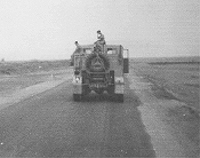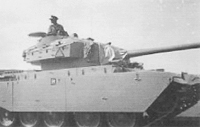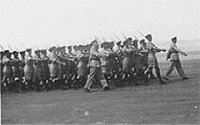REME, 3 INFANTRY WORKSHOP SHANDUR 1953-55
CORUNNA CAMP, FAYID, MELF 17
As Remembered By George Shotton
First Impression - Shandur Garrison
In the early hours of Sunday, May 10th, 1953, HMT Dunera docked
at Port Said. This marked the end to our 10 day holiday cruise that began at
Southampton. Later that May morning, those of us who had various engagements
booked at places of Special Interest to visit - and stay, disembarked. The rest,
bound for other lucrative destinations such as Aden, Malaya, Hong Kong or Korea,
remained aboard.
The next stage of our journey was by courtesy of Egyptian style
first class rail travel; stopping at selected stations and other halts on our
journey south. First impressions included how hot it was. As for the rail journey,
Comfort & Security were the key words that spring to mind. Comfort, no window
in the carriages - this improved ventilation and a mixture of smells. Wooden
slatted seats, they helped keep the occupants awake - for those lucky enough
to get a seat; and toilets (one per carriage) lacking doors and cleanliness
- this reduced the use of such facilities. The Security provided by accompanying
alert armed troops. They took up vantage points atop and around the carriages
to each stop. Did they think we'd abscond?
First stop; Ismailia. We were greeted by a noisy clamour on the
platform. Various Egyptians selling goods or drinks, trying to seperate the
uniformed passengers from their cash. Older, wiser heads aboard the carriage
- experienced from previous tours here - quickly advised to have nothing to
do with these salesmen. Most of us heeded this advise, a few bold ones did not.
Those with postings local to Ismailia left the train here. Later on in the journey
there was a refreshment stop at some lonely spot with little sign of habitation.
Our armed escort patrolled around the perimeter of the train with some watching
from their carriage top position. We alighted, stretched our legs and enjoyed
the tea and sandwiches provided by a willing team of civilian women. Obviously
we had been expected and therefore planned ahead of our arrival. Suddenly from
somewhere in the track side vegetation three small children appeared. Two young
boys and an equally young and shy girl. It seemed the boys had in mind making
a few 'ackers' from the uniformed travellers. A united chorus of "clear
off" and "no thank you" was the response to the young lad's offer
- selling their sister's services! The guards shooed and chased them off; even
so before they disappeared she'd gone through the routine of raising the front
of her shabby clothing. The innocence no longer so.
On board the train again we continued our journey until we arrived
at Fayid. Unlike Ismailia there was no station, no platform and no salesmen.
Here the track was surrounded by sanded waste ground. Months later I realised
our halt that day was a few yards distant from the RMP Roundabout Camp. While
across the other way in the direction of the Canal, about 300 yards distant
was the outer Western Boundary of Corunna Camp - home to HQ REME 1 Infanty Division.
On leaving the 'comfort' of Egyptian National Rail, depending on our final destinations,
we were directed to a number of waiting Army 3 Ton (Passenger carrying) lorries.
We climbed aboard and seated amidst khaki clad legs and intruding kitbags etc.
braced ourselves for this final leg of our journey. Of course those remaining
on the train were destined for Suez for other parts of the deep south.
We were all REME personnel, all bound for the same destination.
3 Infantry Workshops at Shandur. Our transport headed out onto the Canal Road
and aimed the bonnet due south. Shandur was about midway between Fayid and Suez
and graced the ground between the Canal Road and the Canal itself. By now thirst
and the pangs of hunger were starting to twitch within us. We'd disembarked
from the Dunera at 10:00 hours and it was now around 16:00 hours. How much farther?
How long to go? What sort of place is it? As the journey had proceeded from
Port Said, the scenery, the sights and sounds; the endless sand, the flies and
the heat had instilled in my mind that Egypt was not anything like attractive.
A sense of imprisonment came to mind especially when I thought about the duration
of my anticpated 18 months posting here.
Then we got our first glimpse of Shandur. A sprawling collection
of tents, marquees and building of all shapes and sizes. The lot surrounded
by masses of rolls of barbed wire, and fences of the stuff. But it was the sight
of the road block ahead of us that held our attention. A huge tank (breed? I
can't remember) with its menacing gun pointing straight at us. Another of similar
dimensions stood a few yards beyond on the other side of the road facing south.
The pair creating a chicane type road block. Definitely not something to be
messed with. Once more that feeling of imprisonment floated over me. We turned
in through the main gates of the Garrison and proceeded on towards 3 Inf. Workshops
REME. On the way we passed a variety of other units - Infantry, Guards, Armoured
and Service Corps. Our Camp was right at the back, we were the last stop before
the Canal. Our front and flanks were well covered by other units, whilst guarding
our back was the Suez Canal. Of course between our Camp and the Canal was the
ever present deterrent - barbed wire, masses of it in huge coils entangled into
two on the bottom and one on the top. If getting in was a problem, getting out
was just as difficult.
On that first day - May 10th, 1953 - we finally entered the Camp
that was to be home to us for a long time. Our delivery transport stopped outside
the main office block - a collection of jigsaw fitted Nissan huts - and we descended,
bringing our kit with us. We made our way inside the reception office and were
documented (taken on strength for accomodation and feeding purpose). We were
then directed to our hotel accomodation, Army style 6 man marquee tent. I was
shown inside - concrete floor, single swing lamp (electric bulb on a hanging
length of electric wire). There was little choice of which bed, mine was the
only empty one. Iron frame bed, standard issue unyielding Army mattress. Two
pillows (that retained the stains and sweaty smells of previous occupants),
a pair of pillow cases, two sheets, three hairy blankets and a bottle green
mosquito net. First job was to make my bed (being Sunday it was the maid's day
off!!). Next task stow my kit and make my way over to the cookhouse, one of
the other lads of the tent led the way. This would be my first meal since breakfast
aboard the Dunera - railway siding sandwiches do not a proper meal make.
The spartan surroundings of the Camp did little to encourage happiness
within me; but it was not good moaning about it, others here had got used to
it and so would I. Briefly the Camp layout was functional, it was not intended
to be a holiday camp. By the entrance gate, also the way out, was a tent designated
- Camp Guard Room. During those 'magic' hours 18:00 to 06:00 half a dozen OR's
and Cpl Guard Commander resided with (except when they were on post outside
by the gate). The remainder of the Guard (6 or 8, I can't recall) were located
at, within or beside the various parts or buildings of the Workshop Sections
i.e Vehicle Repair, Instruments etc. As I recall there was no perimeter guard
posts (as in many other Camps in the Canal Zone). The fact that our rear boundary
was the barb wire protected Canal removed the need for such Guard requirements.
Then there was the additional security to our Camp by those units located north,
south and west of us.
The Adminstration Buildings (reception and OC's office) stood
a few yards back from the Camp road, on the right after passing through the
gated entrance. Maybe another 30 yards or so further back and a similar distance
beyond were the Q.M. Buildings, which included the Armoury. Further still, in
the direction of the Canal, maybe a hundred yards or so, on slightly higher
ground, was the OR's tented accomodation. A box formation of some 12 or 18 large
size tents (small marquee). Straight ahead from there apart from toilets there
was just empty space right up to the Canal. Shower block and other ablutions
were to one side of the tent block. To the immediate left side of the entrance
gate was the Laundry block followed by buildings that housed the various sections
of the Workshops. This left hand section of the Workshops sort of followed acurve
created by the next door unit's boundary fencing. At the far end of the Workshop
area stood the Cookhouse building, a large marquee provided us with dining room
facilities. Immediately next (on the right) to the 'dining room' was another
large marquee - this was the camp NAAFI. To the front side of the NAAFI, facing
south, was a large and immaculate surface, an area that was roped off, this
was the Camp Sports Field. Though mainly used for playing cricket - the OC was
most keen on playing cricket. Beyond the end of the Sports Field were the OR's
tent lines.
In Camp social life was dependent on a man's liking, or not, of
Stella, cigarettes, writing letters home, reading or the occasional Housey Housey
in the NAAFI. There was a Garrison cinema and a social centre (cups of tea,
soft drinks, writing paper, razor blades and sweets). These provided off-duty
relaxation comforts (took you mind off your day to day trials and tribulations).
There was also a Garrison M.I. Centre that dealt with the basic daily ailments
soldiers can, and did, have - cuts, bruising, athlete's feet, toothache, prickly
heat, bowel disorders and sunburns - anything major meant a trip to BMH Fayid.
Sunburn - We hadbeen at the Camp (3 Inf Workshops) a few weeks
when another, smaller, intake arrived. They, like us, soon established themselves
and settled into the working routine. Somewhere and sometime during those first
few days off duty, three of them had done a bit of serious sunbathing. Serious
it really was, the skin on their upper torsos peeled and the loose skin hung
from their bodies in large sections. Following essential medical treatment they
found themselves observing that early morning ritual - Left, Right, Right Turn,
Halt, Salute - charged with ? It was rumoured 'damage to W.D. property' but
I'd say more likely 'inappropriate conduct likely to commit self inflicted wounds'.
What their punishment was I don't recall, probably just admonished. Certainly
a stern rollicking from the OC then the same from the CSM and probably another
from the Workshop Section NCO.
Coronation Day Parade
We were rigorously drilled each morning in preparation for the
Coronation Parade held at RAF Kasfareet
REME Scammell Recovery vehicle which broke down en-route
to the Parade from Shandur
|

The Parade formed up at Kasfareet
|
Armoured inclusion from 5th Inniskilling Dragoons
|
REME Company 1st Inf Div REME W/shops
|

Royal Marines
|
The Guards (not sure if Grenadier or Coldstream)
|
A VISION OF BEAUTY - FROM TIMES PAST!
During the era of Suez Canal Zone duties Corunna Camp, Fayid was
home to Garrison and Divisional troops. Day time security of Corunna was covered
by the Garrison troops while night time Camp Guard was dealt with by the Divisional
troops. The main guard room was at the north end entrance to the camp and close
to the link road that ran due west to east from the Treaty Road to the Canal
Road.
About 200 yards further back from the Main Guard Room and across the other
side of the main road through the camp was a collection of buildings that were
enclosed within it own security perimeter of sandbagged walling and topped with
barbed wire. This was an Operations Room that dealt with all manner of incoming
and outgoing messages relating to “things most secret and confidential”.
It was always referred to as Corunna Ops Room. At night there was a detailed
guard maintained there to deter any possible intrusion or trespass by unwanted
persons (terrorists). Thus the Guard was known as Corunna Ops Room Guard and
they along with the statutory Camp Fire Piquet joined the Main Camp Guard at
the nightly Guard Mounting Ceremony.
The Main Guard comprised 15 O.’s, a Cpl Guard Commander and 2 L/Cpl i/c
Reliefs. Curunna Ops Room Guard had 9 O.R.s, a Cpl and 2 L/Cpls. 6 O.RO was
the content of the Fire Piquet. The Orderly Sgt and the Orderly Officer rounded
up the total on Parade to 39 – that disregards any unfortunates parading
behind the Guard by way of CB or other punishment.
Guard mounting was prompt 18:00 hours; and this ceremony took place at a semi-secluded
area to one side of the main camp road that ran directly through the Camp from
north to south. To the right (east) of this Parade area was a building that
shielded the entire length of the area. On the left (west) side a long, wide
and reasonably high bed of shrubbery isolated the parade area from the nearby
camp road.
The Parade assembled in order, Main Guard, Corunna Ops Guards, Fire Piquet
with ‘also rans’ tagged on at the rear, al facing north. Main Guard
in line with the top end of the shrubbery so they had more of a view of the
nearby camp road. Most nights about the time of Guard people passed by on that
road and were in view of those on Parade. Obviously military experience, self
preservation and edicts of the MML dissuaded anyone on Parade from allowing
their state of “at attention” to be distracted.
Deeper into the camp, further back from where this Guard Mounting Ceremony
took place, there was approved civilian workers tented accommodation. One of
these workers, reputed to be a Palestinian chef, and his Greek wife lived there.
As time of Guard Mounting drew near we’d gather in readiness and then
form up into our required Guards. By now the sun was beginning to drop closer
to the horizon on our far left. The Ceremony would proceed once the Orderly
Sgt had saluted his greeting to the approaching Orderly Officer. The Officer
accompanied by the Sgt would go along the ranks in turn, inspecting for all
the customary requirements of dress, shave, haircut, boots, beret, brasses,
rifles or stens and attentive posture. When all had been inspected the respective
Guard Commanders would take up a fresh position ready to march the Guard off
and away to their duties.
Usually, though not every night, just as the formalities of inspection were
about complete, or just completed, we’d hear approaching footsteps on
the adjacent road – someone having entered the Camp was now heading south
through the Camp. This was not the usual steady, heavy, clatter of military
hobnailed footwear. These steps were sharper, staccato sounding. We knew, recognised,
it was the sound of an approaching female. We knew from “informed tent
gossip” that this approaching female was the Greek wife of the aforementioned
Palestinian chef. We were also aware, from our previous sightings that she was
a “vision to behold”. A mixture (to our minds) of Gina Lollobrigida
and Sophie Loren. She was always attractively dressed, and decently attired,
an eye pleasing sight amid all the khaki regalia.
Bear in mind the collective military knowledge, quoted above, of the assemble
Guards. That whilst on Parade no one, but no one must move. But it’s certain
that as this vision of beauty passed by some three dozen pairs of eyes gave
a unified and voluntary eyes left. Yet never a head moved nor a word spoken!
Back to REME
Back to Army Units
Back to Canal Zoners
Memories
Back to Main Page





